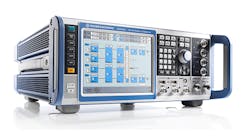Generating wideband digitally modulated signals at V-band frequencies and higher can be challenging, and often requires multiple instruments. In the application note, “Wideband mm-Wave Signal Generation and Analysis,” Rohde & Schwarz describes a simplified method to generate and analyze modulated signals in the V-band frequency range. By using the latest test instrumentation, users can analyze millimeter-wave modulated signals with a bandwidth as high as 2 GHz.
V-band frequencies are used for the wireless-local-area-network (WLAN) IEEE 802.11ad standard, which exploits a 1.76-GHz modulation bandwidth in single-carrier mode. In addition, 5G applications may use V-band frequencies in the future. Test-equipment suppliers must therefore provide the capability to test wideband, digitally modulated signals at these millimeter-wave frequencies. The application note demonstrates a setup to both generate and analyze these signals.
The setup incorporates an SMW200A vector signal generator (VSG). An arbitrary waveform generator (AWG) is used to externally modulate the VSG, thereby creating a wideband digitally modulated signal. After this signal is upconverted to a frequency in the V-band range, the FSW67 signal and spectrum analyzer performs wideband signal analysis. By adding a suitable harmonic mixer to the setup, an FSW43 or FSW50 model can be employed in place of the FSW67. After the FSW analyzer downconverts the signal to 2 GHz, it is then digitized by the company’s RTO digital oscilloscope.
The app note presents typical performance of the proposed test setup. In the example, the VSG generates a 5-GHz intermediate-frequency (IF) signal. Quadrature phase-shift-keying (QPSK) modulation with a 1.6-Gsymbol/s symbol rate is applied to the IF signal by means of an AWG. After the IF signal is upconverted to 58 GHz, an error vector magnitude (EVM) of 3.3% is measured by the FSW analyzer. Another example demonstrates the test setup’s performance when generating and analyzing an IEEE 802.11ad signal. Lastly, the note provides an analysis of two additional applications: a commercial IEEE 802.11ad transmitter and a commercial V-band transceiver for backhaul applications.
Rohde & Schwarz, Mühldorfstrasse 15, 81671 München, Germany; (800) 837-8772
